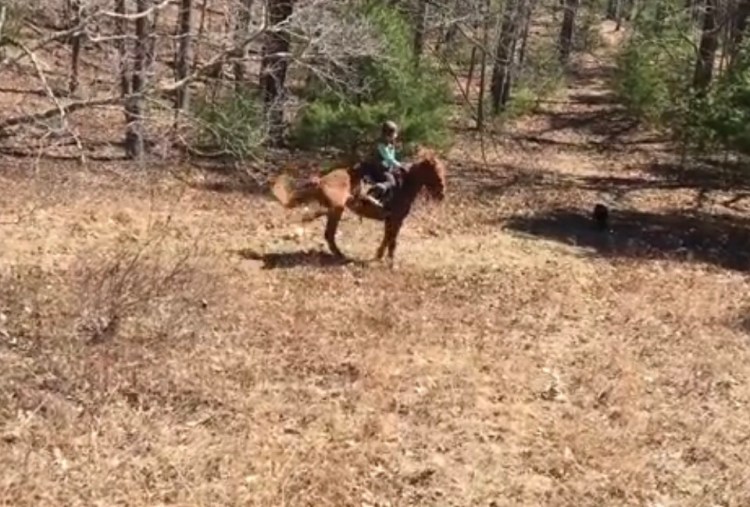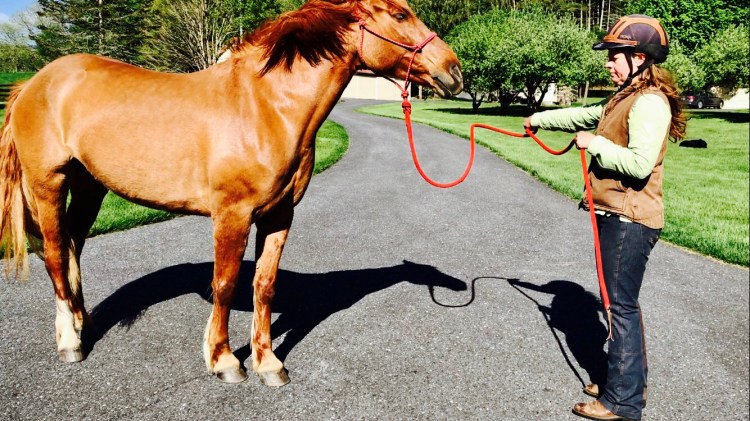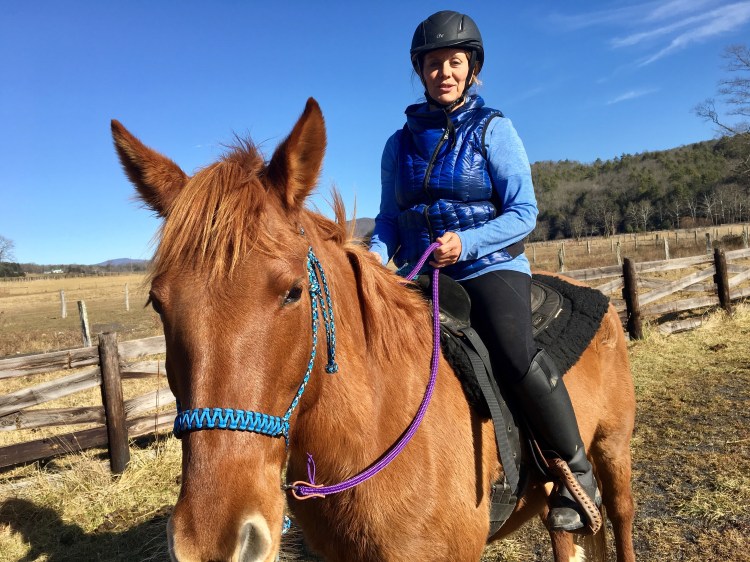Monday, May 1, 2017
I haven’t updated Heart’s journey in a while. I have been writing more about Khaleesi as she so far is having a good 3rd season as an endurance horse.
The other side is that I haven’t been sure what exactly to write about. I’d been watching her progress nicely then gradually begin to sort of unravel on the trail and first I needed to understand it myself.
I chose a mustang mare for varied reasons from talking to others I know who own them: good feet, hearty, ability to take care of herself, big heart, and the belief that I would learn a lot from the process.
Well I was right on with all of it. And I’m getting quite an education.

(Big yawn as we work though some early groundwork over the winter)
The big picture that I was trying to make sense of included a horse that always chose the humans over the herd in the field – Wild Heart is not hard to catch (in fact she catches us as Buck would put it) and is willing to leave her herdmates to fly solo with either Susan or I in the barn.

She has become safe to tie, calm to saddle and tack up, good with picking up her feet for you to work with, Susan had gotten her quiet and still at the stool to mount, she was already started under saddle and no trouble to ride in the arena, been ponied along the trails and she had been willing to lead or follow being ridden on the trail.
Then one ride she laid down while Susan was riding her. This isn’t the end of the world – Khaleesi has done this in a muddy pool because it feels good. I discourage it but it gives my friends a big laugh as it only happens when I’m not ready for it!
Susan would get back on her and we continued to ride just longer enough that she’d soften again and be willing to continue then we’d turn around. She did this in various ways sometimes trying more often than others and sometimes she would lay down when we got back to the barn yard… but we took it in stride and let her sort it out.
The approach was not to get overly upset with her for it, but to firmly let her know riding was her job and laying down to roll did not get her out of it.
The saddle fit is good, her back is fine, and we were only walking and the rides were less than 5 miles. She had been ponied on the same trails without rider to build mental and physical fitness first. None of this seemed unreasonable to getting a horse started.
Then maybe a month ago or so she stopped at the top of a hill and refused to go. Susan is a good rider and insisted firmly without fear. I rode on with Khaleesi to encourage her not to be left behind. Nothing worked. She planted her feet and wouldn’t go on and when asked to move forward she would crow hop, kick, back and circle.
Always on the lookout for when a nice horse might be asking for help- and not interested that anyone get hurt I suggested seeing if Susan could hand walk her down the hill. She has seemed uncomfortable on hills before- but nothing I could put my finger on. Just building the muscle? Was it that she wasn’t comfortable yet and the dogs were too close with her crowding her space? Was something pinching in her tack?
It took some effort even then but Susan was able to walk her ahead of me down the hill. Her hind seemed slightly stiff maybe? Then not... at the bottom susan got back on and the mare again refused to go. We experimented- I took the lead rope and ponied her… this time she went willingly. Eventually Susan took up the reins again and heading back toward home was just fine.
The next ride she began refusing right in the front yard. I picked up the lead and she came along without fuss.
Odd. If she’s in pain, why would she be ok with being led?
Susan took back control and was ok for a short time then still less than a mile from home the mare dug her heels. Spun, kicked at her, hopped, mini bucks, backing- anything but forward.
Does this have to do with susan? I didn’t think so. Susan had been doing great with the mare. Still I felt that it would be a factor to rule out.
We traded horses and I got on Heart and asked her to move along.
No.
She did the same to me. I had a little more tolerance for pushing her past the behavior and riding out some of her antics without fear. I held on, melted into the saddle and stayed calm willing to unemotionally insist that she do her job. Can I push her through this?

I wasn’t angry, afraid or frustrated. Mostly curious and trying to figure out what she was saying.

I got nowhere.

This is the point I was certain I needed help. Not that I couldn’t continue to work with the mare but I wasn’t sure what she was saying exactly. If I didn’t understand what she needed I risked destroying her connection to us with the wrong human response.
I needed the right direction not to ruin this horse. Not to mention keep us from getting hurt.
In my opinion the thing that makes a good horsewoman is taking the actions of the horse which could mean at least 4 different things (likely more) and accurately assessing if the horse is saying.
- I’m hurting and I can’t go on like this.
- I don’t understand what you want and am going to shut down out of confusion.
- I am afraid and am certain I will die if you force me to do this.
- I am not in the mood to haul a human around the trails and if I can find a way to get out of working I’ll do it. I think I can take you.
We needed to get this right and she was speaking so loudly at this point I knew it was time; to respond wrong would devastate our future success with her.
I had an idea.
I hand walked her forward just ahead on the trail to a clearing and gave Susan my phone. I needed somewhere safe to try one more time and if we ended up in rodeo I didn’t want ditches, trees and obstacles on all sides.
I mounted and asked her to go then insisted firmly. Same crow hopping, mini bucks, spinning in circles and backing.
Note: I’m a decent rider but if that horse meant me harm she could have tossed me. She was communicating. She didn’t at that point want to hurt me or Susan. I am certain of that.
We got the rodeo show on video and I sent it to Dee from Simple Equine Teaching for a consult. Thankfully this was a couple weeks before she’d be here in person. We could begin with whatever she suggested and when she came we would see how it was going and what next.
Video is limited and wasn’t very close up but Dee gave me some feedback and Susan and I went back into the arena with Heart to back up in the process and simplify. We rode her but without any hands/steering and just asked her to be ok with carrying a rider in a walk- any direction for now is ok!
First step to rule out confusion or mixed signals from her rider.
She started with some argument but got more comfortable with the task and she did improve in there over time.

We still weren’t certain we’d gotten to the bottom of it….
The week before Dee came I ponied Heart on a very short walk (no saddle) and all went ok until she tossed her head and communicated major discomfort on the last two significant hills descending home to the barn. My mom and I both felt something was physically off with her we took our time (listened to her) as she navigated down the hill.
I suggested Susan hand walk her across the street the next day to see if she noticed anything off. Heart picked a major fight with her to even go up the hills where the two used to hand walk with no trouble at all a couple months back.
Bingo. Something was off.
But what was still unclear. It wasn’t so obvious to see what exactly wasn’t right… no heat or swelling, her canter was choppy in the pasture but she didn’t seem injured exactly. could it be ulcers? Alignment out (chiropractic work?)
When Dee arrived the following day Susan went to get the mare and as we watched through the barn window the mare’s hind was very stiff just walking in.
It was fascinating watching Susan and Dee work with Heart. She had some pretty serious energy conflicts in her body. Meridians and axis and poll things awry (a whole language I’m not familiar with) She had issues in her stifle and neck- these things she communicated to them as we watched her move her body as Dee and Susan worked with her.
This whole process I can’t explain, but I can say as Dee showed Susan where to touch the horse with very little pressure we all watched the mare change in front of us- relaxing, moving off then inviting her back to ‘do that again‘, sometimes a tiny jerk and the way she would hold her body then shift was mind blowing.
That very day she already moved better, and after day two I watched her canter through the pasture with fluid motion where in the weeks leading up she was stiffer and choppy. Night and day.
No vet. No medication.
Energy work. Then her following up that work by adjusting herself further.
But that’s only half of the story. Wild Heart had begun gradually to respond disrespectfully to things she was uncomfortable with.
I want to be clear here. I have heard most horse-people I know talk about respect and disrespect and now in my personal experience I am going on a limb to say disrespect is pretty rare and the term is grossly overused.
I’ve seen horses worried, unsure, fearful, confused, questioning- all things some people often lump into ‘disrespectful’ but it is not at all the same.
When you ask something from a horse, and she doesn’t want to do it, then looks at you and decides she is going to fight instead of flee and she will hurt you if she is able… that is disrespect and it looks very different than confusion, fear or worry.


Also it isn’t generally the case that a horse ‘is’ disrespectful on the whole. You can have a horse go through all kinds of responses to a request and a few moments of disrespect that turn into either respect or curiosity or vice versa doesn’t make a bad horse.
The mustang mare can flip pretty rapidly between questions, respect and disrespect and I am getting a quick education on how to get my human responses in line fast to act appropriately.

The other part of what the clinic provided was tools to communicate quickly and effectively when Heart chose to be disrespectful- things that would hopefully keep me safe and change the conversation bringing our relationship back where she was willing and saw us as good leaders paired with some physical healing she needed to do in order to feel better, relax and start to work again.
One of the common mistakes I’ve seen is (especially women) when needing to respond with big communication from a horse is to get emotional. I don’t mean they cry or become a hormonal mess- mostly they use anger and frustration. Anger seems to help generate big energy, however it is still an emotion and a horse will never accept an emotional leader.
Horse leaders respond appropriately to the situation and go back to their cool, relaxed selves eating or drinking or whatever it is they were doing just seconds ago before the offense. It’s that quick. And when they get the situation handled (which is with exactly the volume necessary no more no less) it’s over. They don’t continue to punish or chase or ‘impose more control’. They don’t continue to work the disrespectful horse. They get what they asked for (out of my space, don’t touch my food, etc) and then move on.
It’s in the moment. The past… 2 seconds ago… is over.

One thing I’ve noticed is that the situation is defused quickly- not amped up into an emotional frenzy which is the usual response that humans have when they are afraid, angry, or frustrated.
My job when Heart decides to take me on and question if I’m leadership material is to not be fearful (control breathing, be aware of heart rate), calmly (like I have no doubt I can successfully take on a 1200 pound wild animal) but firmly stand my ground and use my tools to communicate that I’m smarter and stronger than she is.
After all if I can’t keep her from eating grass when she suppose to be working for me, how can I be trusted to keep the mountain lions at bay, or to provide the food she needs, or make the right decisions when we’re out in the woods together.
More domesticated horses just don’t have the high level survival drive a wild one does so she goes from zero to life or death quicker than the other horses I work with.
Still I have faith in the mare. She is a good horse full of spirit and heart. She is going to make an excellent partner when she realizes she has a cush life now and doesn’t have to fight anymore- she can get along with her new family and be treated very well.
It’s a slower process but completely worthwhile and both Susan and I are committed to success and giving the process the time it takes.
After over a week of regular but short sessions I am seeing improvement. At first her language was loud and aggressive at times, now her disrespectful moments are less intense and more half-hearted. She is healing and I am learning and growing.
One thing is for certain, learning to work with a horse who chooses disrespect at times does make you better if you get through it effectively. It will make me better with all the horses I work with- and it has shown me what disrespect isn’t. Which has been one of the most valuable parts of this experience for me.
I still believe that slow IS fast and that once we sort some of these things out she will come right along and be a truly fine horse.





